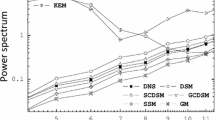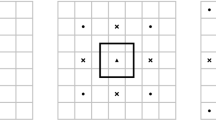Abstract
In turbulence simulations, the small scales of motion, even if they carry only a very small percentage of the whole kinetic energy, must be taken into account in order to accurately reproduce the statistical properties of the flows. This induces strong computational restrictions. In an attempt to understand and model the nonlinear interaction between the small and large scales, a dynamic multilevel procedure is proposed and applied to homogeneous turbulence. As in large eddy simulation, filtering operators are used to separate the different scales of the velocity field. In classical models (Smagorinsky), only the large scale equation is resolved. A different approach is proposed here. Indeed, by analyzing the nonlinear interaction term in the large scale equation, we show that they locally have a very small contribution to the whole dynamic of the flow. We then propose to treat them less accurately. Specific treatments for these terms are achieved by a space and time adaptative procedure; the cut-off value (filter width) which defines the scale separation varies as time evolves. Simulations at Re λ in the range of 60 to 150 have been performed until statistical steady states are reached, i.e. over long time period. Comparisons with direct simulations (DNS) show that this numerical modeling provides an efficient resolution of the nonlinear interaction term. The multilevel algorithm is shown to be stable; the corresponding simulated flows reach a statistically steady state very close to the DNS ones. The shape of the energy spectrum functions as well as the characteristic statistical properties of the velocity and its derivatives are accurately recovered.
Similar content being viewed by others
REFERENCES
Batchelor, G. K. (1953). Theory of Homogeneous Turbulence, Cambridge University Press.
Burie, J. B., and Marion, M. (1997). Multi-level methods in space and time for the Navier-Stokes equations. SIAM J. Num. Anal. 34.
Canuto, C., Hussaini, Y., Quarteroni, A., and Zang, T. A. (1988). Spectral Methods in Fluid Dynamics, Springer Verlag, New York.
Chen, S., Doolen, G. D., Kraichnan, R. H., and She, Z. S. (1993). On statistical correlations between velocity increments and locally averaged dissipation in homogeneous turbulence. Phys. Fluids A 5(2), 458-463.
Deardorff, J. W. (1970). A numerical study of three-dimensional turbulent channel flow at large Reynolds numbers. J. Fluid Mech. 41, 453-480.
Debussche, A., Dubois, T., and Temam, R. (1995). The nonlinear Galerkin method: A multiscale method applied to the simulation of homogeneous turbulent flows. Theoret. Comput. Fluid Dyn. 7(4), 279-315.
Dubois, T., Jauberteau, F., and Temam, R. (1993). Solution of the incompressible Navier-Stokes equations by the nonlinear Galerkin method. J. Sci. Comput. 8(2), 167-184.
Dubois, T., Jauberteau, F., and Zhou, Y. (1997). Influences of subgrid scale dynamics on resolvable scale statistics in large-eddy simulations. Physica D 100, 390-406.
Erlebacher, G., Hussaini, M. Y., Speziale, C. G., and Zang, T. A. (1992). Toward the large-eddy simulation of compressible turbulent flows. J. Fluid Mech. 238, 155-185.
Foias, C., Manley, O. P., and Temam, R. (1988). Modeling on the interaction of small and large eddies in two-dimensional turbulent flows. Math. Mod. and Num. Anal. (M2AN) 22(1), 93-114.
Jauberteau, F. (1990). Résolution Numérique des Equations de Navier-Stokes Instationnaires par Méthodes Spectrales. Méthodes de Galerkin non Linéaire, Thesis, Université de Paris-Sud.
Jauberteau, F., Rosier, C., and Temam, R. (1989). The nonlinear Galerkin method in computational fluid dynamics. Applied Numerical Mathematics 6, 361-370.
Jauberteau, F., Rosier, C., and Temam, R. (1990). A nonlinear Galerkin method for the Navier-Stokes equations. Comput. Math. Appl. Mech. Eng. 80, 245-260.
Jimenez, J., Wray, A. A., Saffman, P. G., and Rogallo, R. S. (1993). The structure of intense vorticity in isotropic turbulence. J. Fluid Mech. 255, 65-90.
Kerr, R. M. (1985). Higher-order derivative correlations and the alignment of small-scale structures in isotropic numerical turbulence. J. Fluid Mech. 153, 31-58.
Lions, J. L., Temam, R., and Wang, S. (1996). Splitting up methods and numerical analysis of some multiscale problems. Comput. Fluid Dyn. J. (special issue dedicated to A. Jameson) 5(2), 157-202.
Manley, O. P. (1992). The dissipation range spectrum. Phys. Fluids A 4(6), 1320-1321.
Moin, P., and Kim, J. (1982). Numerical investigation of turbulent channel flow. J. Fluid Mech. 118, 341-377.
Monin, A. S., and Yaglom, A. M. (1975). Statistical Fluid Mechanics, Vol. 2, MIT Press.
Orszag, S. A. (1973). Lecture on the Statistical Theory of Turbulence. Proc. Summer School in Theoretical Physics, Les Houches.
Orszag, S. A., and Patterson, G. S. (1972). Numerical simulation of three-dimensional homogeneous isotropic turbulence. Phys. Rev. Lett. 28, 76.
Reynolds, O. (1895). On the dynamical theory of incompressible viscous fluids and the determination of the criterion. Phil. Trans. Roy. Soc. London A 186, 123-164.
Schumann, U. (1975). Subgrid scale model for finite difference simulations of turbulent flows in plane channels and annuli. J. Comput. Phys. 18, 376-404.
She, Z. S., Jackson, E., and Orszag, S. A. (1988). Scale-dependent intermittency and coherence in turbulence. J. Sci. Comput. 3(4), 407-434.
Siggia, E. D. (1981). Numerical study of small-scale intermittency in three-dimensional turbulence. J. Fluid Mech. 107, 375-406.
Siggia, E. D., and Patterson, G. S. (1978). Intermittency effects in a numerical simulation of stationary three-dimensional turbulence. J. Fluid mech. 86(3), 567-592.
Smagorinsky, J. (1963). General circulation experiments with the primitive equations: I. The basic experiment. Monthly Weather Rev. 91, 99-164.
Smith, L. M., and Reynolds, W. C. (1991). The dissipation-range spectrum and the velocity-derivative skewness in turbulent flows. Phys. Fluids A 3, 992.
Temam, R. (1996). Multilevel methods for the simulation of turbulence. A simple model. J. Comput. Phys. 127, 309-315.
Vincent, A., and Meneguzzi, M. (1991). The spatial structure and statistical properties of homogeneous turbulence. J. Fluid Mech. 225, 1-20.
Woodward, P. R., Porter, D. H., Edgar, B. K., Anderson, S., and Bassett, G. (1995). Parallel computation of turbulent fluid flow. Comp. Appl. Math. 14(1), 97-105.
Author information
Authors and Affiliations
Rights and permissions
About this article
Cite this article
Dubois, T., Jauberteau, F. A Dynamic Multilevel Model for the Simulation of the Small Structures in Homogeneous Isotropic Turbulence. Journal of Scientific Computing 13, 323–367 (1998). https://doi.org/10.1023/A:1023223217210
Issue Date:
DOI: https://doi.org/10.1023/A:1023223217210




